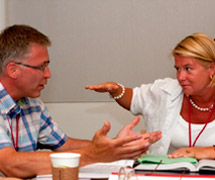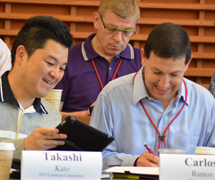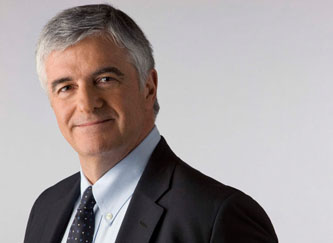SEP has more than lived up to my expectations. The professors are the foremost thinkers in their fields and my fellow students brought tremendous experience from a wide range of industries. The robust nature of the coursework, activities, study groups, and individual conversations along the way allowed me to push myself both personally and professionally, maximizing my future contributions in the workplace.
– Tom Andriola
Vice President and General Manager
Royal Philips Electronics N.V.
SEP gave me tremendous exposure to executives in diverse industries from all around the globe allowing me to learn from them within Stanford's rigorous academic setting and in compelling discussions outside the classroom.
– Sanjay Mehrotra
President and Chief Executive Officer
SanDisk Corporation
SEP really helps put a career in focus. All of us left with ideas that have powered us through the year, and will last for years ahead. And most important, we formed a lasting bond. The rule in our class is that if you travel to the vicinity of a classmate, you've got to give him or her a call, and get together for lunch, dinner, or a drink.
– Alan S. Murray
Deputy Managing Editor, the Wall Street Journal
Executive Editor, the Wall Street Journal Online
The Stanford experience allowed me to step outside my role as a scientist and to see the business environment in a new light. The faculty are true artists that combine their expertise with a wonderful ability to set the stage for maximum learning.
– Ludger Dinkelborg
Head of Molecular Imaging
Bayer Schering Pharma AG
I left SEP with confidence and exuberance. I gained a new global perspective that was not only induced by the highly qualified and seasoned faculty, but also was expanded by the interaction I had with my classmates, who came into the program after already achieving much success in their careers. SEP is truly a professional and personal growth experience—an opportunity to step out of your day-to-day life and focus on learning, networking, and expanding your horizon.
– Gail Coury
Vice President, Risk Management
Oracle Corporation
When you come to Stanford, you have to be willing to have your traditional way of thinking challenged. An open mind and enthusiasm to participate will lead you to a truly transformational experience.
– Paul Umbrazunas
COO and Head of Business Development
Credit Suisse Australia
At Stanford, I found an environment that fosters collaboration and provides an opportunity to really engage with your fellow participants and discuss and learn from each other's challenges. The diverse background of the participants makes for a richer experience.
– Kimberly S. Bowers
Chairman of the Board, Chief Executive Officer and President
CST
I was impressed by the unique Stanford experience created by the professors, the program content, and my fellow participants. The insights and new approaches I have acquired will be of great value as I develop a new global vision for my organization.
– Javier González-Soria
Managing Director, Google Travel Spain
Google, Inc.







































